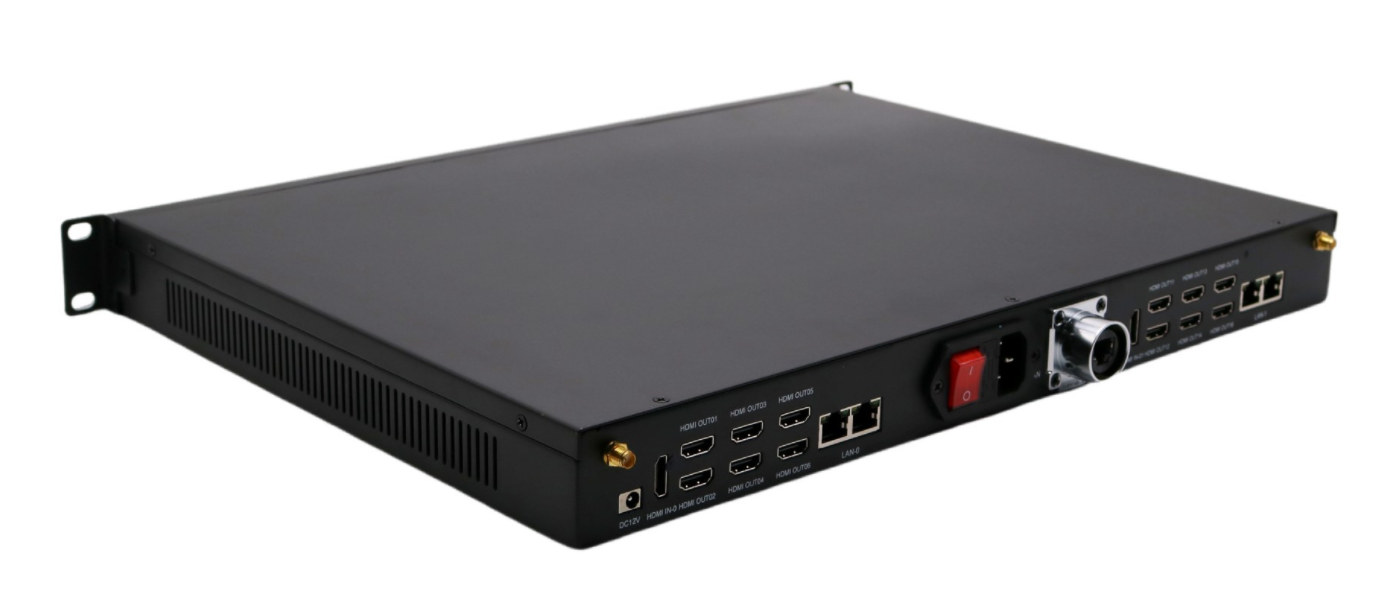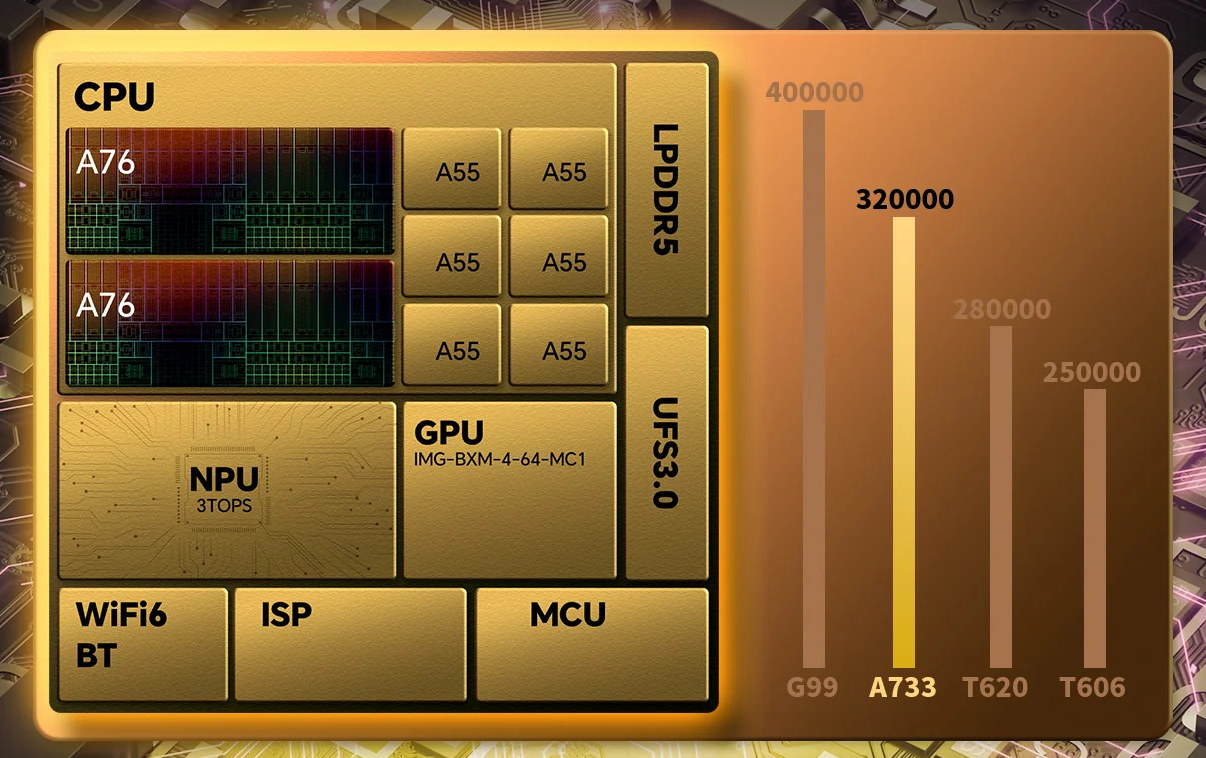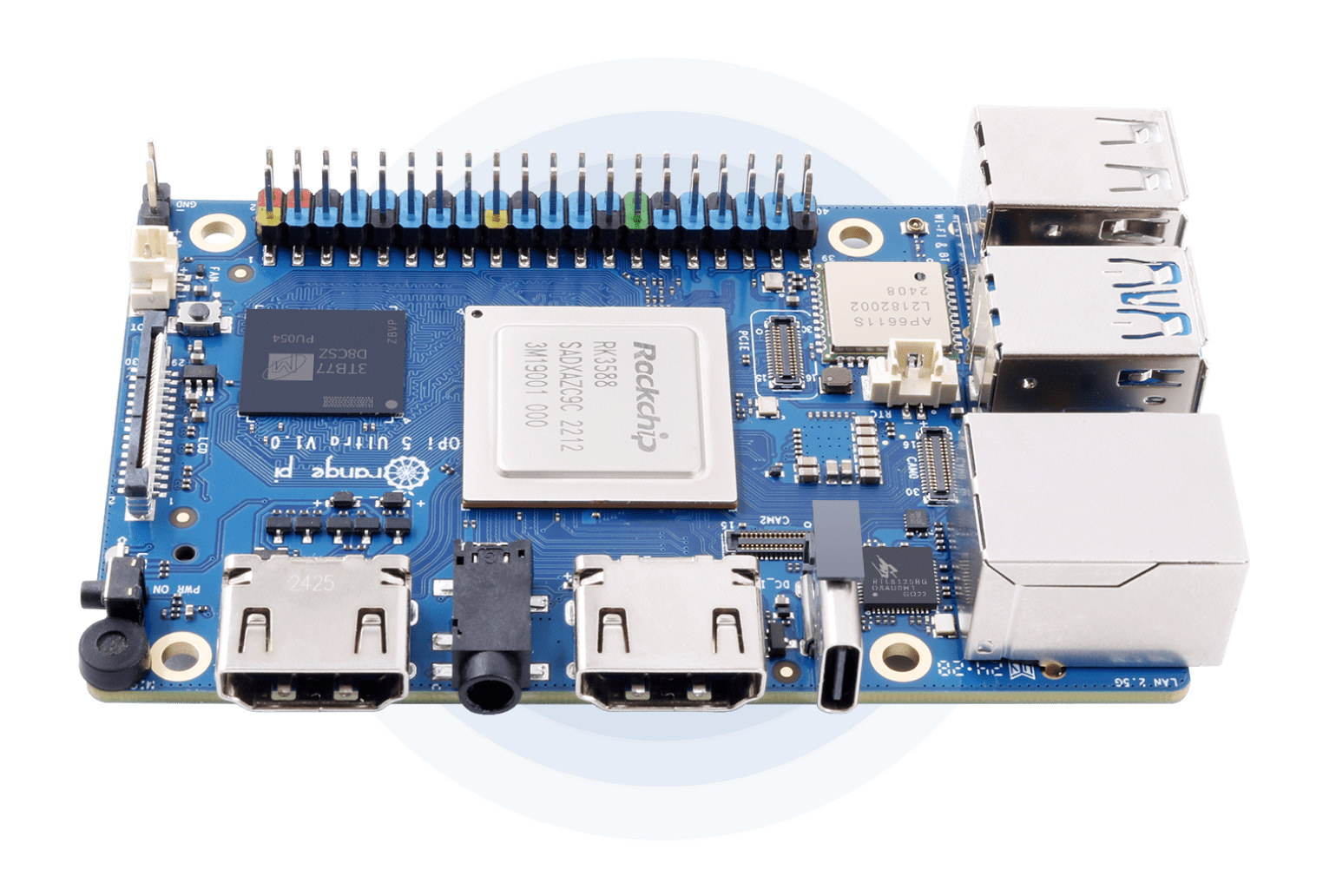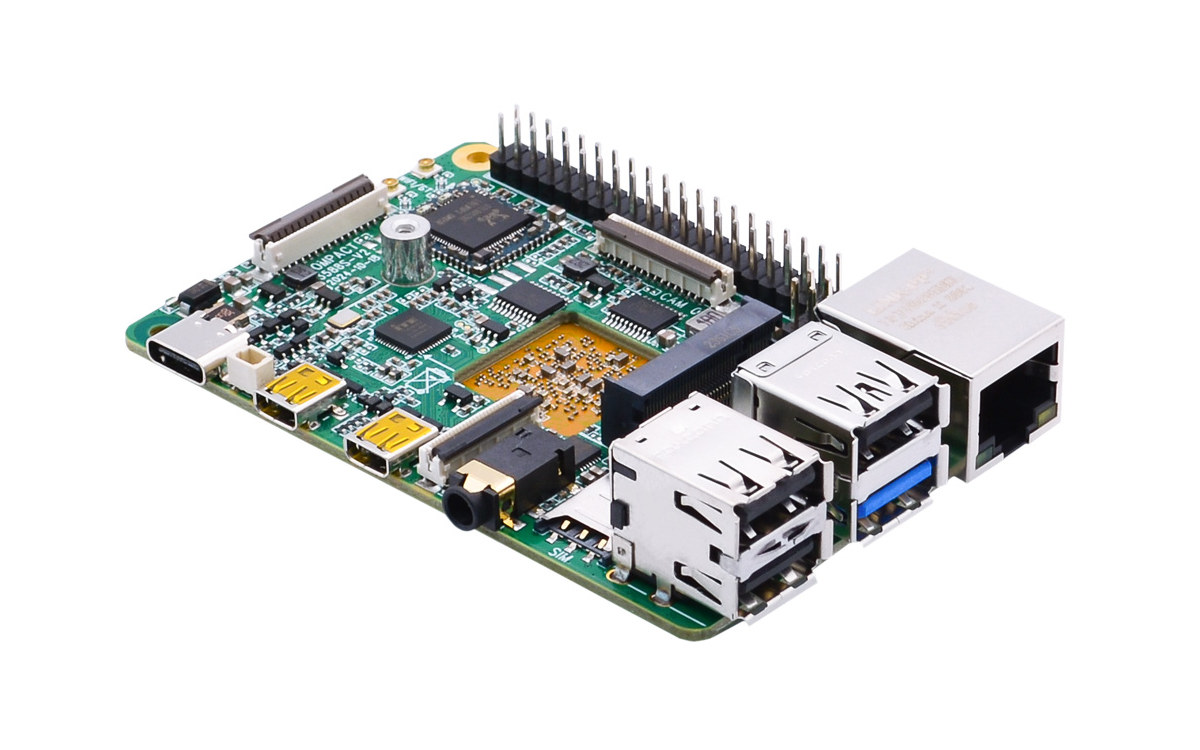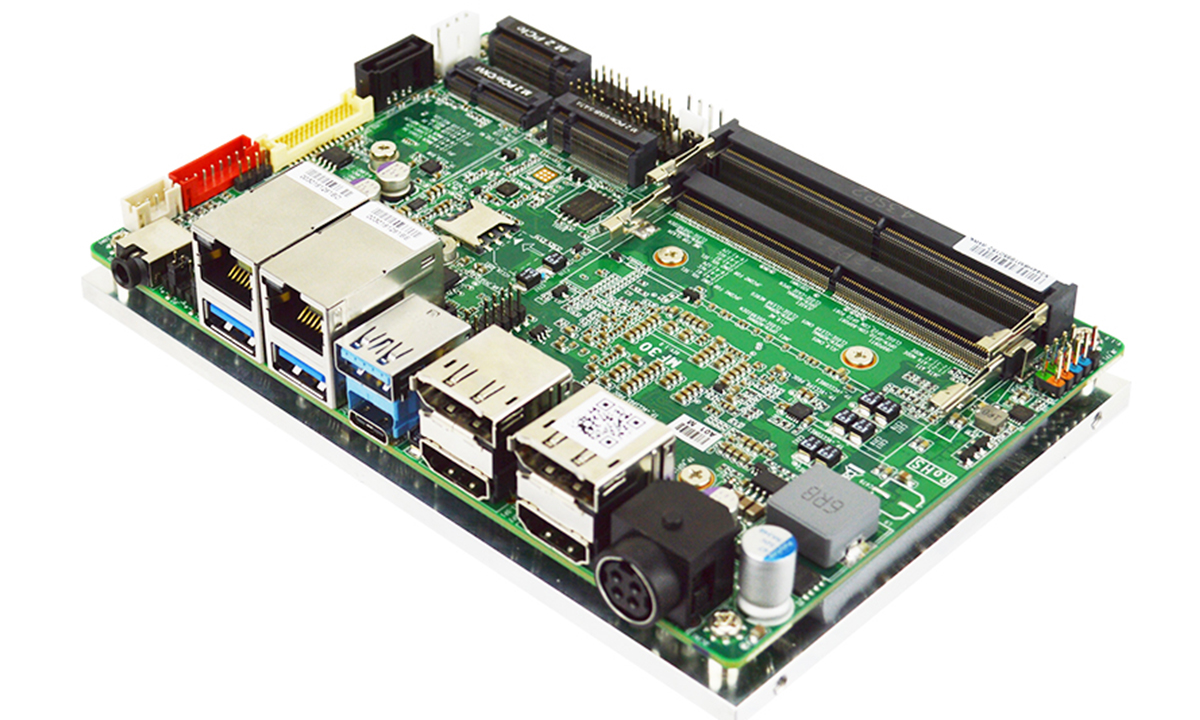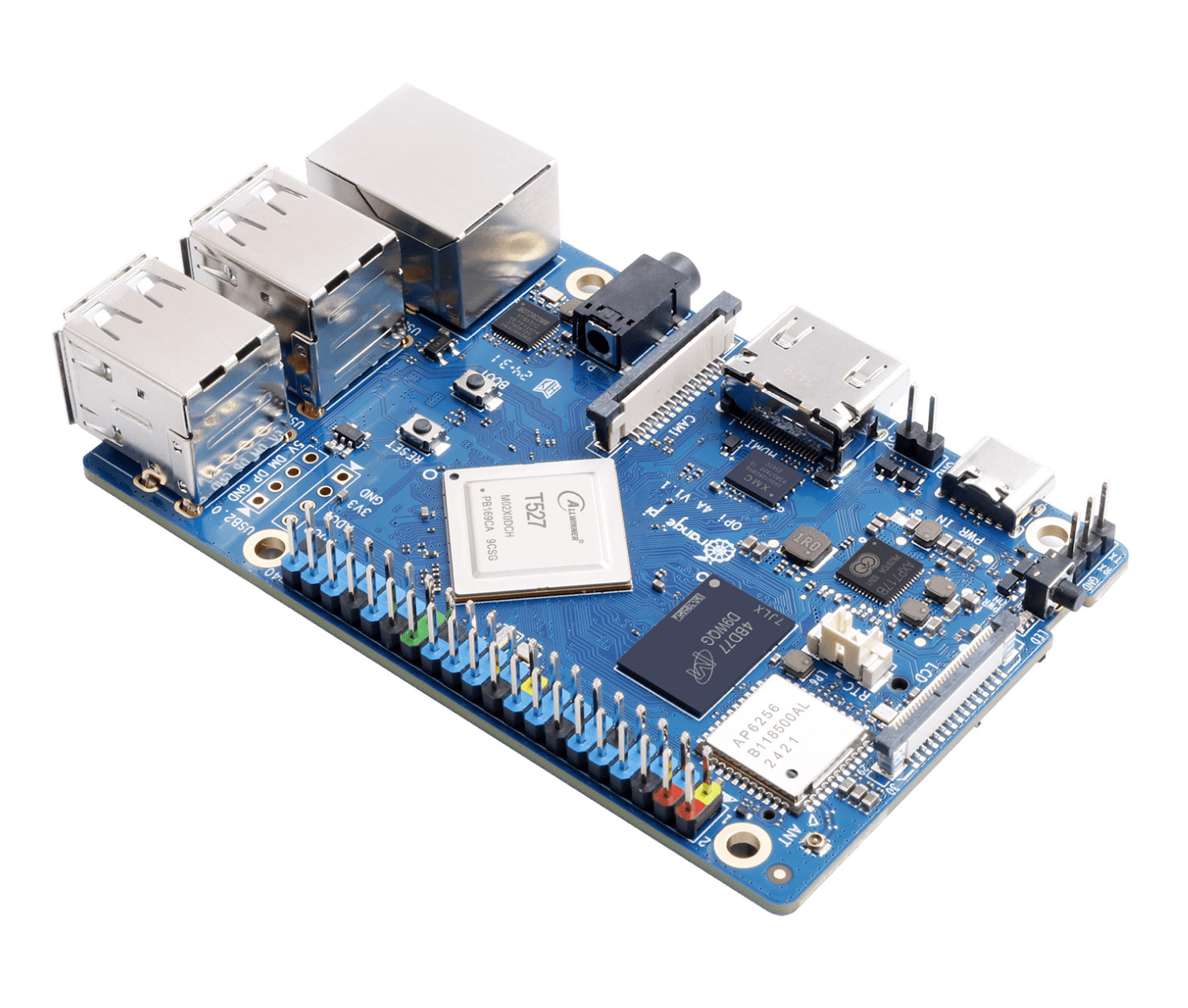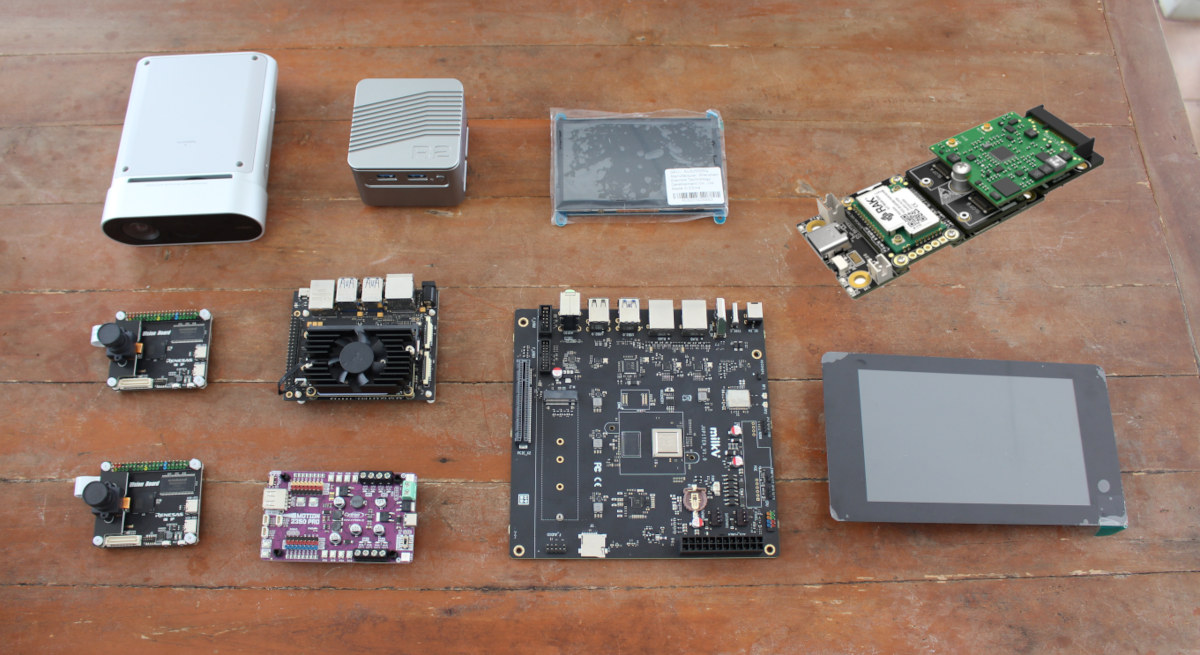Mekotronics R58-HD-1U is a digital signage player with 12 independent HDMI outputs implemented through three Rockchip RK3588 SoCs, housed in a 1U standard chassis, and mostly designed for video walls and other applications where multiple displays are close to each other. Each Rockchip RK3588 processor is coupled with up to 16GB RAM and 128GB eMMC flash, and the system also offers two HDMI inputs, five Ethernet ports, WiFi 6 and Bluetooth, and seven USB ports for expansion. Mekotronics R58-HD-1U specifications: SoCs – 3x Rockchip RK3588 each with CPU – Octa-core processor with 4x Cortex-A76 cores @ up to 2.4 GHz, 4x Cortex-A55 cores @ up to 1.8 GHz GPU – Arm Mali-G610 GPU with OpenGL ES 3.2, OpenCL 2.2, and Vulkan 1.2 support VPU 8Kp60 video decoder for H.265/VP9 codecs 8Kp30 video decoder for H.264 codec 4Kp60 video decoder for AV1 codec Multi-channel decoder in parallel AI accelerator – 6 […]
Allwinner A733 octa-core Cortex-A76/A55 AI SoC supports up to 16GB RAM for Android 15 tablets and laptops
Allwinner A733 is an octa-core Cortex-A76/A55 processor with an optional 3 TOPS NPU and support for up to 16GB RAM designed for Android 15 tablets and laptops such as the Teclast P50Ai with a 10.92-inch touchscreen display. With two Cortex-A76 cores, six Cortex-A75 cores, an Imagination BXM-4-64 MC1 GPU, and an NPU, the Allwinner A733 looks very similar to the Allwinner A736 we noted in a roadmap last year. But there’s no news about the A736, so maybe the name was dropped and the Allwinner A733 was launched instead. Allwinner A733 specifications: CPU Dual-core Arm Cortex-A76 @ up to 2.00 GHz Hexa-core Arm Cortex-A55 @ up to 1.79 GHz Single-core RISC-V E902 real-time core GPU – Imagination Technologies BXM-4-64 MC1 VPU 8Kp24 H.265/VP9/AVS2 decoding (no mention of AV1) 4Kp30 H.265/H.264 encoding AI accelerator – Optional 3 TOPS NPU Memory 192 KB SRAM + 512 KB shared SRAM 32-bit LPDDR4/LPDDR4x/LPDDR5 interface […]
Orange Pi 5 Ultra SBC offers HDMI 2.1 output and HDMI 2.0 input
The Orange Pi 5 Ultra is a Rockchip RK3588 SBC that’s slightly larger than a business card and visually identical to the Orange Pi 5 Max introduced last August, but replacing one of the two HDMI 2.1 video outputs on the latter with an HDMI 2.0 input port. The new single board computer is still offered with up to 16GB LPDDR5, an eMMC flash module connector or soldered-on eMMC flash, an M.2 socket for an NVMe SSD, 2.5GbE and WiFi 6E networking, and four USB 3.0/2.0 ports. Orange Pi 5 Ultra specifications: SoC – Rockchip RK3588 CPU – Octa-core processor with 4x Cortex-A76 cores @ up to 2.4 GHz, 4x Cortex-A55 cores @ up to 1.8 GHz Arm Mali-G610 MP4 GPU with support for OpenGL ES1.1/2.0/3.2, OpenCL 2.2, and Vulkan 1.2 6 TOPS AI accelerator with support for INT4/INT8/INT16/FP16 mixed operation VPU – 8Kp60 H.265/VP9/AVS2 10-bit decoder, 8Kp30 H.264 decoder, […]
Boardcon Compact3588S SBC – A Raspberry Pi 5 alternative based on Rockchip RK3588S AI SoC with M.2 socket for SSD or 4G LTE module
Boardcon Compact3588S SBC is another Raspberry Pi 5 alternative powered by a Rockchip RK3588S octa-core Cortex-A76/A55 SoC with a 6 TOP NPU for AI acceleration, up to 16GB RAM, up to 256GB eMMC flash, and all the features found in the Raspberry Pi 4, plus an M.2 socket supporting either an NVMe SSD or a 4G LTE module in conjunction with a Nano SIM card slot. It more closely follows the Raspberry Pi 4 form factor, but Rockchip RK3588S’ performance and capabilities make it a direct Raspberry Pi 5 competitor. Contrary to most credit card-sized single board computers, it follows a carrier board + soldered-on system-on-module design, rather than a single PCB. Boardcon Compact3588S specifications: SoC – Rockchip RK3588S CPU – Octa-core processor with 4x Cortex-A76 cores @ up to 2.4 GHz, 4x Cortex-A55 cores @ up to 1.8 GHz GPU – Arm Mali-G610 GPU with OpenGL ES 3.2, OpenCL […]
The first Android 16 developer preview is out (much) earlier than expected
Google releases a new Android version every year, and while the first Android 15 developer preview was released this year in February, the company has already announced the first Android 16 developer preview just a couple of months after the official release of Android 15 on AOSP in an “effort to drive faster innovation in apps and devices”. More specifically, Google plans to release two Android APIs next year: a major SDK release in Q2 2025 instead of Q3 followed by a minor SDK release in Q4 2025 that won’t include behavior changes that may require changes in apps, but only pick up feature updates, optimizations, and bug fixes. The change was mostly made to better accommodate the device launch schedule of smartphone manufacturers. That almost means many more changes are expected between the preview and the beta release. As of now, Google has only announced a few new features […]
Jetway MF30 – A 3.5-inch SBC with 13th Gen Intel Core i5-1335U/1335UE Raptor Lake SoC, quad display support
The Jetway MF30 is a 3.5-inch subcompact board powered by 13th-generation Intel Core Raptor Lake-P U-series processors, including the Intel Core i5-1335U and Core i5-1335UE. Designed for embedded applications such as digital signage, control systems, gaming setups, and transportation hubs, the board supports versatile high-definition multi-screen configurations with two HDMI ports, two DisplayPorts, one Type-C DP, and one LVDS/eDP interface. For connectivity, the MF30 offers dual 2.5GbE ports, three USB 3.2 Gen2 ports, four USB 2.0 ports, and a USB Type-C port, while storage options include SATA III port and M.2 (2242/2280) sockets. Jetway is well known for its SBCs, and we’ve previously covered products like the JMTX-ADN8, JNUC-ADN1 mini-ITX motherboard, and JF35-ADN1 3.5-inch motherboard all powered by the Intel N97 CPU. Additionally, we’ve explored other SBCs and Mini PCs featuring 13th-gen Raptor Lake SoCs, including the iBASE IB961, GEEKOM GT13 Pro, Cincoze DV-1100, and LattePanda Sigma. If you’re interested […]
Orange Pi 4A low-cost octa-core SBC is powered by Allwinner T527 Cortex-A55 AI SoC with a 2TOPS NPU
Orange Pi 4A is a new low-cost credit card-size single board computer (SBC) powered by an Allwinner T527 octa-core Cortex-A55 processor with a 2TOP NPU and offered with either 2GB or 4GB RAM. The board also comes with multiple storage options: a 128 or 256Mbit SPI NOR flash for the bootloader, an eMMC socket for up to 128GB modules, an M.2 socket for NVMe SSDs, and a microSD card slot. It’s also equipped with four USB 2.0 ports, a gigabit Ethernet port, three display interfaces (HDMI, MIPI DSI, eDP), two camera interfaces, and a 40-pin “Raspberry Pi” header. The Orange Pi 4A is somewhat equivalent to an octa-core Raspberry Pi 3/4 with some extra features. Orange Pi 4A specifications: SoC – Allwinner T527 CPU Octa-core Arm Cortex-A55 @ up to 1.8GHz (four cores) and up to 1.42 GHz (four cores) XuanTie E906 RISC-V core @ 200MHz GPU – Arm Mali-G57 […]
Giveaway Week 2024 winners announced!
We’re now ready to announce the winners of CNX Software’s Giveaway Week 2024. We offered some of the review samples we tested (and some we did not test) in the last year, and for the fourth year running, RAKwireless also gave away two IoT development kits shipped directly to winners. This year’s prizes also included a RISC-V motherboard, a 3D depth camera, a few Arm development boards, two touchscreen displays, and an Alder Lake-N mini PC/router. All those products can be seen in the photo, minus some accessories. You’ll find more than seven devices because we organized the third Giveaway Week on CNX Software Thailand simultaneously with four prizes. We had seven winners on CNX Software: Jupiter RISC-V mini-ITX motherboard – François-Denis, Canada Orbbec Femto mega 3D depth and 4K RGB camera – Reifu, Japan RAKwireless Blues.ONE LoRaWAN, LTE-M, and NB-IoT devkit – OldCrow, Portugal Mixtile Core 3588E development kit […]


